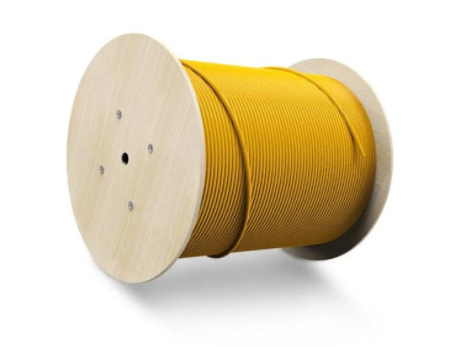Co Cable de Fibra óptico Oufu, Ltd
Enderezo: Shenyang, Liaoning, China.
Persoa de contacto: Xestor Zhang
Teléfono: 400-964-1314
Teléfono móbil: 86 13904053308
?
2025-09-17 16

Simply put, an MPC multi-purpose distribution cable is a tight-buffered, indoor-rated Cable óptica de fibra that houses multiple optical fibers within a single protective jacket. It is engineered for robust performance in building interiors, supporting applications like LAN backbones, data center interconnections, and multimedia distribution. The "MPC" designation often highlights its multi-purpose capability, balancing flexibility, durability, and ease of termination. Unlike loose-tube cables designed for outdoors, this type excels in controlled indoor fiber optic environments.
Why choose an MPC-rated distribution cable over other indoor options? The answer lies in its optimized design for flexibility, handling, and termination efficiency.
| Feature | MPC Multi-Purpose Distribution Cable | Traditional Tight-Buffered Cable |
|---|---|---|
| Design Purpose | Versatile (LANs, data centers, vertical risers) | Often application-specific |
| Flexibility | High (Typically optimized for tight spaces) | Moderate |
| Jacket Durability | Riser or Plenum Rated (Fire safety compliant) | Varies; may require separate certification |
| Installation Ease | Superior (Lightweight, easy to route) | Heavier, less manageable |
| Termination Speed | Fast (Tight-buffered fibers simplify termination) | Similar but less streamlined |
As shown, the MPC distribution cable excels in adaptability. According to a 2024 report by BICSI, structured cabling installations using multi-purpose distribution cables saw a 30% reduction in labor time due to easier handling and termination.
Www.adsscable.cn
Proper installation is critical to performance. Follow these steps for the best results with your MPC multi-purpose distribution cable.
Step 1: Pre-Installation Pathway Assessment
Survey the intended route—ceiling plenums, risers, or under-floor spaces. Check for sharp edges, excessive heat sources, or obstructions. Ensure compliance with local fire codes (e.g., plenum-rated cables in air-handling spaces). Measure the exact length needed to avoid slack, which can complicate management.
Step 2: Gently Pull the Cable
Use the cable’s central strength member for pulling, never the fibers themselves. Maintain tension below the manufacturer’s limit (usually under 100 lbs) to avoid damaging fibers. For longer runs, use cable lubricants approved for the jacket material. Avoid tight bends exceeding the minimum bend radius (often 20x the cable diameter).
Step 3: Secure the Cable Properly
Use velcro ties or cushioned clamps to secure the cable along its route. Avoid over-tightening zip ties, which can compress fibers and induce signal loss. In vertical risers, use cable trays or hooks to support the weight and prevent stress on the fibers.
Step 4: Prepare for Termination
Strip the outer jacket carefully using a dedicated cable slitter to avoid nicking the inner fibers. Organize fibers sequentially to avoid mix-ups. For fiber optic termination, use high-quality cleavers and fusion splicers to ensure low-loss connections.
Step 5: Test and Document
After termination, test every fiber with an OLTS (Optical Loss Test Set) or power meter to verify end-to-end loss is within budget. Use an OTDR for troubleshooting if needed. Label both ends of each fiber clearly and update documentation for future maintenance.
Www.adsscable.cn
Even experienced installers can make errors with these cables.
Mistake 1: Exceeding the bend radius during installation, causing micro-bends and increased attenuation.
Mistake 2: Ignoring fire safety ratings, such as using riser-rated cable in plenum spaces, which violates building codes.
Mistake 3: Poor cable management after installation, leading to strained fibers or difficulty identifying connections later.
Not all multi-purpose distribution cables are identical. Select based on:
Fire Safety Rating: Plenum-rated (CMP) for air-handling spaces, riser-rated (CMR) for vertical runs between floors. General purpose (CM) may suffice for non-critical areas but check local codes.Www.adsscable.cn
Fiber Count: Determine current needs and future growth. MPC cables are available in configurations from 6 to 144 fibers, supporting scalable network design.
Jacket Material: PVC jackets are common, but low-smoke zero-halogen (LSZH) options are critical in spaces where toxic smoke is a concern during fires.
With the rise of IoT, 5G small cells, and smart buildings, the demand for flexible, high-bandwidth indoor cabling is accelerating. The MPC multi-purpose distribution cable is ideal for this evolving landscape, offering the density, safety, and performance required to support next-generation applications. Its role in simplifying installations and reducing labor costs makes it a strategic choice for modern network infrastructure.
Your Pre-Installation Checklist:
[Checklist]
Verify the required fiber count and fire rating (plenum/riser) for the application.
Measure the pathway length accurately, including service loops.
Ensure all installation tools (slitters, pullers, tension monitors) are ready.
Confirm compliance with local building and fire codes.
Schedule time for post-installation testing and documentation.
[/Checklist]
1. Q: Can MPC multi-purpose distribution cable be used outdoors?
A: No. These cables are designed for indoor use. They lack the waterproofing and arMáis.d protection needed for outdoor or burial applications. For outdoor runs, transition to an outdoor-rated cable using a sealed enclosure.
2. Q: How does the cost compare to traditional indoor fiber cables?
A: The cost is generally competitive. However, the total installed cost is often lower due to easier handling, faster termination, and reduced labor time, providing excellent long-term value.
3. Q: What does "MPC" stand for in these cables?
A: While not a universal standard, "MPC" in this context typically denotes "Multi-Purpose Cable," emphasizing its versatility for various indoor applications like riser, plenum, and general purpose use.
4. Q: What is the typical lifespan of this cable inside a building?
A: When installed correctly and not physically disturbed, a high-quality MPC multi-purpose distribution cable can easily last 25 years or Máis., supporting multiple upgrade cycles.
5. Q: Can I mix single-mode and multimode fibers in one MPC cable?
A: Generally, no. These cables are typically manufactured with all one fiber type (e.g., all OM4 multimode or all OS2 single-mode) to maintain consistency. Hybrid cables are specialty items and not standard in the MPC distribution category.